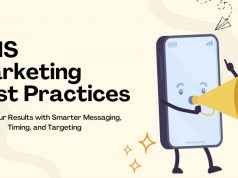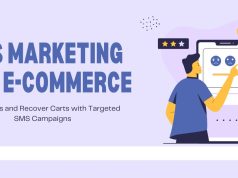With open rates up to 98% SMS marketing puts a message in your customer’s pocket. But building a successful SMS marketing campaign is about more than just sending text messages, and you have to think about strategy, timing, and staying narrow to compliance rules. This guide will explain everything you need to know to set up SMS campaigns that yield real results for your business.
Understanding SMS Marketing Fundamentals
It is a form of marketing where businesses can reach directly to its customer base by sending them promotional messages directly on their mobile phones via text message. And unlike with email marketing, which might languish unread in a cluttered inbox, the very presence of the message already alerts them to your mood.
It is that SMS is immediate and personal flying in the face of why it’s so powerful. Making Text Messages Feel Personal Text messaging offers a higher level of intimacy compared to other marketing channels, allowing you to better connect with your audience and are perfect for last-minute sales, appointment reminders and last-minute updates. But, this closeness also means that SMS marketing is a medium in which frequency, timing, and messaging need to be thought about very carefully.
The best SMS campaign will feature a mixture of something promotional with something interesting. Effective campaigns are not 100% sales messages, they’re about order confirmations, shipping news, exclusive information and useful content that subscribers will actually appreciate.
Building Your SMS Subscriber List
Building your SMS subscriber list isn’t exactly like building your email list. Texts are seen as a bigger interruption, and people are less inclined to give out their phone number to you for no reason.
Clear value propositions for SMS sign-ups. This could be special discounts, early access to sales, or other important services. Ensure prospective subscribers know exactly what they will receive and how often you will be touching base.
Collect numbers from different sources. Incorporate SMS opt-in forms on your website, offer sign-up opportunities at checkout, push your SMS program on social media, and train in-store staff to talk about SMS advantages to customers.
Leverage lead magnets that are tailored for SMS campaigns. Provide them with instant discounts, free shipping codes, or free downloadable resources if they sign up for your email today! This immediate pay-off mitigates any reluctance about exchanging phone numbers.
Legal Compliance and Best Practices
SMS marketing is very strict, and penalties for non-compliance are steep. The TCPA mandates that you get consent before sending ads to cell phones. This means customers need to actively opt in — you can’t add phone numbers from other sources without a customer’s consent.
Use the double opt-in to make consent explicit. After people subscribe, send a confirmation message that details what they’re signing up for and how to unsubscribe. Keep accurate records of when and how each subscriber was signed up – it’s documentation that may be needed if you find yourself under compliance scrutiny.
Ensure you include easy-to-follow opt-out instructions on all messages sent. If you are automatically sending them a text of every change, then common phrases should be included in the body of every message (ie, ‘Reply STOP to unsubscribe’) should be in the body of every advertising message. Validate unsubscribe requests at once and remove all phone numbers from your list without delay.
Be mindful of timing restrictions. Don’t send messages prior to 8 AM or past the hour of 9 PM in the domain timezone of your prospect. Take your audience’s lives and likes into account while planning your messaging for optimal engagement without being intrusive.
Crafting Compelling SMS Content
Food for thought Every word counts because SMS is limited to 160 characters. Craft short but powerful messages that deliver value and a call to action. Bring urgency here with strong verbs and detailed descriptors to get the reader to act now.
Begin messages with the important details. 4) Put your key offer or call-to-action first, as longer messages in preview screens can be cut off. Back it up with more information and what can be done.
Personalize messages when possible. Address them by name, mention what they ordered before or make special offers based on their tastes. Personalization has been shown to increase response rates; that it makes messages feel more relevant.
Make explicit calls-to-action that direct readers on what action to take. Action words to consider using include “Shop now,” “Claim your discount” or “Book today.” Soften the conversion with a shortened URL that makes it a one-tap action for customers to move from the SMS into the desired response.

Timing and Frequency Strategies
When you send your SMS campaigns however, has a great effect on how well they perform. Texts don’t give customers the luxury of picking up on their own time to read a message when they feel like it – unlike email, for example. That’s why timing is key to finding a balance between engagement and irritation.
In most SMS campaigns, the optimal time to send SMS messages are business hours on weekdays. Engagement : Weekdays, especially Tuesday – Thursday tend to receive the most engagement on B2B platforms, while weekends and holidays may see less depending on your audience and industry.
Take into account your customer’s everyday habits when sending messages. Retail brands may opt to send promotional messages during lunch breaks or early evening hours when individuals are more prone to browsing and shopping. For service-based businesses, business hours when customers are more likely to be able to respond or book an appointment may be the time to target.
Rate limiting is the key to SMS success. Email subscribers can stand to receive daily messages, whereas SMS subscribers generally appreciate the latter half of that cadence. Track engagement closely with frequency and update accordingly based on response and subscriber feedback.
Segmentation and Targeting Techniques
Solid SMS campaign strategies employ segmentation to ensure messages are applicable to the right groups. Segment your subscribers according to who you are targeting and what their previous purchase history has been, level of engagement, and also what they have said their interests are!
You can use geographical segmentation to target location based offers and news. This is especially useful for businesses that have several locations or are conducting regional promotions. Add store addresses, local events, or inventory for their area into your messages.
Behavioral segmentation with purchase history and engagement data makes it easy to send messages that are relevant to a customer’s past buying behavior. Recommend products based on previous sales, re-engage inactive subscribers or simply tap your best customers on the shoulder for a new offer.
Lifecycle segmentation helps make sure your customers are receiving the right messages at each stage of the relationship they have with your brand. New subscribers may be sent welcome series and basic offers, while existing customer may receive loyalty rewards or early access to new products.
Measuring and Optimizing Campaign Performance
Monitor KPIs (key performance indicators) which will help you understand the performance of your SMS campaigns and the areas to make them better. Key performance indicators would consist of such metrics as delivery rates, open rates, click-through rates, Conversion rates and unsubscribe rates.
The delivery rate tells you how many of the messages you sent were successfully delivered to your recipients. Low delivery rates could signify problems with the quality of your phone numbers list, or filtering on the carriers. Keep a close eye on this metric and do keep your list clean to ensure you are achieving high delivery rates.
Click-through rates indicate how many recipients actually do something after getting your email. Low CTRs could = problems with your message, offer/CTA attractiveness or clarity. Experiment with new tactics to boost engagement.
Conversion rates indicate what share of SMS recipients take desired actions, such as making a purchase or scheduling an appointment. This measure directly connects SMS marketing to its impact on the business and justifies the investment in a campaign.
Integration with Other Marketing Channels
SMS marketing is most effective when part of a more comprehensive marketing initiative. Integrate your SMS campaigns with your email marketing, social media, and advertising strategies to deliver unified customer experiences across all customer touchpoints.
Leverage SMS with other marketing channels. Send promotional texts for your new blog posts, social media contests, email newsletter sign ups. This cross-channel promotion will boost your marketing.
Design omnichannel paths for your customers that incorporate SMS touchpoints. E.g., a follow up email campaign with SMS reminders (kickback link), text confirmation for social media contest entries, or litter your social media channels with SMS traffic to special landing pages etc.
“Keep your messaging and branding consistent across all channels but tweak messages and content to reflect the benefits offered by each specific platform. Your SMSs should support consistent brand values and promotion themes as all your other marketing collaterals.
Common Mistakes to Avoid
Numerous companies make common mistakes when starting out with SMS campaigns. Don’t send unsolicited text to someone as it’s against the law and also spoils the image. Always use some sort of confirmed opt-in mechanism and keep good records of clear consent!
Don’t spam your subscribers with too many messages. SMS, unlike email, is also perceived as more intrusive and becomes and unsubscribe request and distaste for the brand after plenty of pushy messages. Begin with conservative frequency, and review once you receive feedback from your subscribers.
Stay away from generic, impersonal emails that do not communicate definitive value. Each SMS message has to add value for the recipient, be it special savings, relevant info or timely notice of a sale. Blah-blah-blah statements with no clear value lays an egg.
Don’t overlook mobile optimization for landing pages and websites linked in SMS messages. Web pages that load fast and offer a great mobile experience are important because people are probably going to click through on their phone.
Advanced SMS Marketing Strategies
After you’ve become proficient in elementary SMS marketing, venture into advanced techniques to gain even better results. Automation sequences can onboard new subscribers, follow up on abandoned carts, or even re-engage dormant customers all without human personalization.
Interactive Both ways Two-way text messaging campaigns that will encourage reciepient responses. Surveys, polls, or just plain questions can help get you feedback and involve the crowd. This engagement will lead to stronger customer relationships and valuable business intelligence.
Customer service – Use SMS to update customers about their orders or remind them of their appointments, as well as answer any faqs they might have. This pragmatic use of SMS marketing is genuinely valuable for customers and decreases support burden.
And don’t forget to integrate SMS with QR codes, geofencing, or mobile app notifications for cutting-edge marketing experiences. These counterpart integrations can help offer more touchpoints and ways of engaging.

Elevating Your SMS Marketing Game
SMS marketing campaign: How to create Self-educating for a marketing campaign is understanding your audience, respecting their preferences and sending them consistent value. Begin with a foundation of legal compliance, clarity, and timing and then build your program incrementally according to results and subscriber sentiment.
When you regard SMS marketing as a relationship key instead of yet another marketing pipe, and when you also make it easy for people to engage with you through SMS, the success of this campaign strategy becomes limitless. They dig deep into what’s truly valuable for subscribers and focus on delivering that value, and subscribers repay them with better engagement and stronger loyalty.
Keep in mind: SMS marketing is a single part of a complete marketing campaign. If successfully integrated with your other marketing techniques and performed in compliance and with customer experience in mind, the benefits of SMS campaigns extend beyond just the significant impact they can have on the bottom line, to building and maintaining valuable customer relationships.
From crafting an SMS marketing campaign that actually works to enhancing local print ads using data-driven insights, combining traditional and digital tactics can lead to stronger marketing outcomes.









